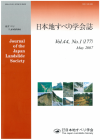All issues

Volume 43 (2006)
- Issue 6 Pages 339-
- Issue 5 Pages 251-
- Issue 4 Pages 185-
- Issue 3 Pages 131-
- Issue 2 Pages 51-
- Issue 1 Pages 1-
Predecessor
Volume 43, Issue 3
Displaying 1-3 of 3 articles from this issue
- |<
- <
- 1
- >
- >|
Original articles
-
Hiroyuki YOSHIMATSU, Kazuo KASHIYAMA2006 Volume 43 Issue 3 Pages 131-141
Published: 2006
Released on J-STAGE: August 03, 2007
JOURNAL FREE ACCESSLandslide mass inflowing into a reservoir or a bay causes giant wave that brings a greatly serious disaster. The numerical analysis of FEM (Finite Element Method) has been discussed for the shallow water equation to predict the wave's quality. The numerical method of FEM gives rise of the local oscillation due to the convection term. The FEM of SUPG (Streamline Upwind/Petrov-Galerkin formulation) applied the interpolation function of first order accuracy is discussed to avoid the local oscillations. This paper examines the stabilized FEM of CIVA (Cubic Interpolation Volume/Area Coordinate) method that uses the interpolate function of the third order accuracy in order to more raise the precision. The presented method is compared with the results of previous model experiment and confirms the validity of numerical analysis.View full abstractDownload PDF (1731K) -
Tatsuo SEKIGUCHI, Hiroshi P. SATO2006 Volume 43 Issue 3 Pages 142-154
Published: 2006
Released on J-STAGE: August 03, 2007
JOURNAL FREE ACCESSA lot of landslides were triggered by the Mid Niigata Prefecture Earthquake around former Yamakoshi Village in the northern part of Uonuma Hill, Central Japan. We conducted photo-interpretation by using aerial photographs that were taken after the earthquake. In this study, landslides of 4,438 slopes in total were extracted. The landslides were distributed on the northern side of Higashiyama Hill near the epicenter. The concentration of the landslides occurred in two zones : “The East Landslide Zone” and “The West Landslide Zone” which are located in the Imo River Basin and in the western part of Higashiyama Hill, respectively. The geological formation of where these landslides occurred consists of Tertiary sandstone, mudstone and siltstone layers. Both of the landslide zones, as well as the geological layers, stretch in a NNE-SSW direction. We found out that the dip-slope type landsides were large-scale formations and tended to slip towards the direction of the dip. There were three causes of the landslides : the severe motion of the Mid Niigata Prefecture Earthquake, lithology and geological structures and unstable landforms such as landslides and river terraces.View full abstractDownload PDF (24651K)
Technical report
-
Shinro ABE, Akihisa TAKAHASHI, Shigeru OGITA, Jun-ichi KOMATSU, Hirosh ...2006 Volume 43 Issue 3 Pages 155-162
Published: 2006
Released on J-STAGE: August 03, 2007
JOURNAL FREE ACCESSDownload PDF (3912K)
- |<
- <
- 1
- >
- >|